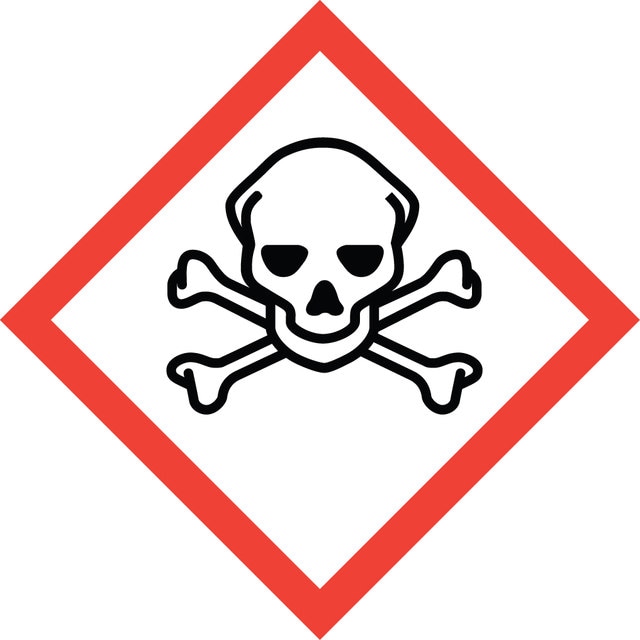725765
2-甲基-4-异噻唑啉-3-酮
95%
别名:
2-甲基-3(2H)-异噻唑啉酮
登录查看公司和协议定价
选择尺寸
关于此项目
经验公式(希尔记法):
C4H5NOS
化学文摘社编号:
分子量:
115.15
Beilstein:
606203
EC 号:
MDL编号:
UNSPSC代码:
12352100
PubChem化学物质编号:
NACRES:
NA.21
质量水平
方案
≥94.0% (GC)
95%
表单
lumps
杂质
≤5% water
SMILES字符串
CN1SC=CC1=O
InChI
1S/C4H5NOS/c1-5-4(6)2-3-7-5/h2-3H,1H3
InChI key
BEGLCMHJXHIJLR-UHFFFAOYSA-N
正在寻找类似产品? 访问 产品对比指南
应用
- Insights into the mechanisms of within-species variation in sensitivity to chemicals: A case study using daphnids exposed to CMIT/MIT biocide.:研究水蚤对2-甲基-4-异噻唑啉-3-酮的不同种内敏感度,说明这些差异后潜藏的生化机制。该发现为环境安全性评估带来重要视点(Kim et al., 2023)。
- Effects of the biocide methylisothiazolinone on Xenopus laevis wound healing and tail regeneration.:该研究评估2-甲基-4-异噻唑啉-3-酮对两栖动物再生过程的影响,有助了解它的生物作用和潜在毒性(Delos Santos et al., 2016)。
- T cell lymphomatoid contact dermatitis: a challenging case and review of the literature.:该综述有讨论2-甲基-4-异噻唑啉-3-酮诱发的接触性皮炎,提供有关皮肤科应用和安全评估的宝贵信息(Knackstedt and Zug, 2015)。
免责声明
The product is not intended for use as a biocide under global biocide regulations, including but not limited to US EPA′s Federal Insecticide Fungicide and Rodenticide Act, European Biocidal Products Regulation, Canada’s Pest Management Regulatory Agency, Turkey’s Biocidal Products Regulation, Korea’s Consumer Chemical Products and Biocide Safety Management Act (K-BPR) and others.
警示用语:
Danger
危险分类
Acute Tox. 2 Inhalation - Acute Tox. 3 Dermal - Acute Tox. 3 Oral - Aquatic Acute 1 - Aquatic Chronic 1 - Eye Dam. 1 - Skin Corr. 1B - Skin Sens. 1A
补充剂危害
储存分类代码
6.1A - Combustible acute toxic Cat. 1 and 2 / very toxic hazardous materials
WGK
WGK 3
闪点(°F)
Not applicable
闪点(°C)
Not applicable
个人防护装备
dust mask type N95 (US), Eyeshields, Faceshields, Gloves, type P3 (EN 143) respirator cartridges
Michael D Lundov et al.
Contact dermatitis, 69(5), 271-275 (2013-10-15)
The prevalence of contact allergy to the isothiazolinone preservative methylchloroisothiazolinone (MCI) in combination with methylisothiazolinone (MI) and MI alone has increased in the last couple of years. To investigate the prevalence of contact allergy to MI, MCI/MI and benzisothiazolinone (BIT)
Julien Mutschler et al.
Toxicology in vitro : an international journal published in association with BIBRA, 23(3), 439-446 (2009-05-16)
Assessment of skin sensitization hazard of chemicals currently depends on in vivo methods. Considering the forthcoming European Union ban on in vivo testing of cosmetic/toiletry ingredients, the search for alternative non-animal approaches is an urgent challenge for investigators today. For
Leena Ackermann et al.
Contact dermatitis, 64(1), 49-53 (2010-12-21)
Antimicrobials constitute the second most common cause of contact allergy to cosmetics. Methylisothiazolinone (MI), previously always used together with methylchloroisothiazolinone (MCI), has recently been approved in the EU for use on its own in cosmetics and also various industrial products.
Eleanor Higgins et al.
Dermatitis : contact, atopic, occupational, drug, 24(2), 73-76 (2013-03-12)
The isothiazolinones methylchloroisothiazolinone and methylisothiazolinone (MCI/MI) are the active ingredients in a frequently used preservative in cosmetic, household, and industrial products. This study reviewed our department's cases of allergic contact dermatitis caused by MCI/MI, outlining their clinical presentation and possible
A Spawn et al.
Neuroscience, 205, 194-204 (2012-01-17)
Methylisothiazolinone (MIT) is a commonly used biocide known to be neurotoxic in vitro. Brief exposure of cortical neurons in culture to MIT results in increased neurodegeneration, whereas chronic exposure of developing neurons in culture to low concentrations of MIT has
我们的科学家团队拥有各种研究领域经验,包括生命科学、材料科学、化学合成、色谱、分析及许多其他领域.
联系客户支持

